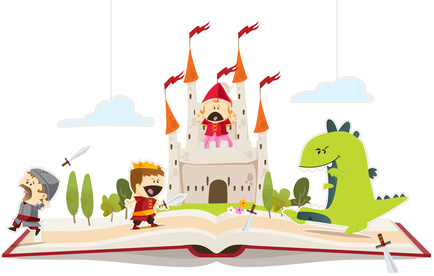8 Lessons Fairy Tales Can Teach You About E-Learning
Good teaching is a mysterious recipe: one part good content, one part excellent presentation, and one part fairy dust that brings the whole thing together. Especially with e-Learning, where students are on their own for much of the process and their education depends on engagement and entertainment, it’s very important to keep that magical element in mind.
We submit that myth, legend, and tall tales have a lot to offer the world of e-Learning. Since learners love stories, why not follow the formula of fantasy to make your e-Learning courses a huge success? Below we offer 8 fairy tale takeaways that you can and should apply to your next e-course or PowerPoint presentation.
1. The Hero Must Always Win
If there’s one thing fairy tales can teach us, it’s that the hero simply has to come out on top. No one wants to watch a movie where the dragon eats St. John, or Grendel trounces Beowulf. The same goes for e-Learning: students need to know their success is assured. You can do this by making it possible for learners to get the right answer and learn material, even if they take a few wrong turns and stumbles. Use hints and tips, repetition, practice quizzes and do-overs to give lots of chances and cement learning.
2. DO Stray Off the Path
In fairy tales, the hero never stays on the path. Neither should you feel the need to stick to a stringently linear plan.
Use creative linking to send learners to other pages in the PowerPoint – such as back to the beginning of that section or to a new chapter entirely – or to websites outside the presentation. Outside sites can provide great enrichment while pages inside the presentation help engage students by letting them choose areas to explore, revisit tough information or skip a chapter until they’re ready.
3. Make the Goal Clear
When a heroine sets out on a quest, she needs to know what she’s questing for, right? Ditto e-Learning: Always make clear what people are striving for. Tell them at the beginning of the course or module (if you’ve broken the course down into smaller pieces) what they are expected to learn during that segment, and how their learning will be assessed (for instance, a write-up, a quiz, a test, or beating a game).
4. A Wise Guide Is Needed
Think Virgil in The Inferno or Dumbledore in Harry Potter. No matter what the tale, heroes always need a sage older guardian to help them along. Well, the same goes for people who are expected to do the hard work of learning on their own. Use video, audio, or written text to engage with them throughout; the simulated guide will make them feel less alone.
5. It’s Always Darkest Before the Dawn
Before the big win comes the valley of doubt and despair. This is a prime tactic for courses too. Right before you plan to deliver good news (a break, a section wrap-up, the end of the course) is when you should make the material the most challenging. With the thrill of victory in sight, learners are especially motivated to make it happen.
6. You Discover Who You Are On Your Own
The hero never learns who he or she really is until finally, all their guides and friends and sidekicks have fallen away and they are on their own. Well, employees using e-Learning are on their own from the start. The magic of this model, of course, is that it allows people to go at their own pace and incorporate the lessons they need in a way that makes sense to them — if you’ve enabled many different learning types, that is. Therefore, try to tailor your lessons to a wide range of learning styles, including visual, audio, and hands-on (digitally speaking).
7. Sometimes the Easy Choice is the Worst Choice
Remember in Indiana Jones and the Last Crusade, when he’s finally standing the room full of grails and looking at the bones of other, lesser people who chose the golden chalices and jeweled goblets? Good old Indy won out by choosing the plainest, most unadorned cup in the room.
If you’re a tricky teacher, you can offer a powerful lesson in the form of easy choices. With
multiple choice practice quizzes, pop quizzes or even actual exams, be sure to incorporate a few answers that seem glittery and right to throw students off track. Once answered, give the actual rationale, helping them see why the easy answer isn’t always the right one. This type of learning really helps people cement information, because they understand not only which answer is correct, but why the easy answers are actually wrong.
8. Truth Is Stranger than Fiction
They say a picture is worth a thousand words. Well, we say a good anecdote is worth a thousand lame explanations. And despite the awesomeness of fairy tales, the best stories are true! Whenever possible, convey information in the form of a powerful story that students can relate to.
Upping the excitement factor in your PowerPoint presentations isn’t hard, but it does challenge course designers to be creative and dig deep. What better way to do that than through harnessing the power of fantastical stories? Do it, then sit back and watch your learning outcomes rise.
Have any e-Learning tips to share with us? Leave a comment below!

